

|
Home Updates Hydros Cars Engines Contacts Links Contact On The Wire Next → |
Tethered Model Car Racing
|
|
Based on the transcript of a talk given by David Giles |
|
What is Tethered Model Car Racing?
The title gave me a lot of scope as to how I presented this story. I decided to try and organize it chronologically and geographically, so that hopefully it gives an idea of how the activity started in America and Great Britain, grew in mainland Europe, both East and West, declined in Great Britain and America, and continued in Australia. I will also bring you up to date with current developments.
Tethered Model Car Racing is a hobby which started in California around 1937 when a group of free-flight model aeroplane enthusiasts, fed up with taking home broken models each weekend decided to ‘tether’ straight running I/C powered model cars. This is a small extract from an interview with Tom Dooling, one of the three brothers who designed and built the famous Dooling racing engines and cars. Of course, they owned the factory of the same name which specialized in producing precision machinings for the American aircraft industry.
"On a Sunday evening in the early part of 1937, my brothers and I were sitting around the fire in the living room, discussing the day’s activities at the Los Angeles Model Airplane field. At that time I was an ardent model airplane fan, had a plane of my own, and like most amateurs in aero-dynamics, I managed to bring my plane home in pieces after each Sunday’s flying.
This particular Sunday evening, the discussion came around to the possibility of building a miniature car powered by a small gas engine similar to the motor used in my airplane. Being like any other average American, I have always had the desire to tinker with gadgets of one sort or another, and this model car idea could not be passed up. The following week, with the aid of my brothers, we assembled our first car"
|
So here we have the beginnings of a brand new hobby, known as tether (or cable) car racing. It wasn’t long before it became competitive, as is the way of such things, and the running sessions became race meetings! Initially speeds were in the region of 40mph (64kph) but it quickly became apparent, as speeds increased, that a prepared track and a secure centre pole were required. Due to the enthusiasm of modellers, and a good deal of commercial support, the hobby blossomed. Many top quality tracks were being built across America in the years 1938 until about 1942, at which point America’s attention was directed elsewhere. The caption from the original image reads "A model race car enthusiast from 1940 getting ready to launch his car. When everything is ready a swift push forward and the car is off on its circular run" |
|
Activity in the States was effectively suspended, or certainly subdued, during the war years but resumed very soon afterwards. This activity continued until around the time of the Korean War when once again the types of talented youngsters involved in the hobby were occupied elsewhere.
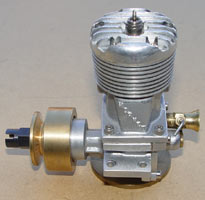 |
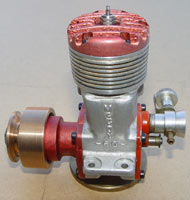 |
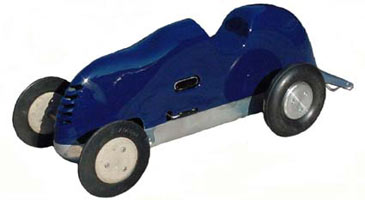 |
| Hornet 60 | McCoy 60 | McCoy Invader Mk I |
There were many dedicated enthusiasts involved in the hobby in these early years, far too many to name in an article of this type. However, two names should be mentioned as they were, in my opinion, at least as influential as the Dooling brothers. They are Ray Snow and Dick McCoy.
Ray Snow was the designer and manufacturer of the ‘Hornet’ engine, arguably the first of the specialist tether car engines with rear disc induction and very heavy and sturdy construction to withstand the rigours of cable car racing. The engine also found its way into speed control line aeroplanes and tethered hydroplanes. To illustrate Ray Snow’s contribution to the early development of the hobby, extracts from an article in the November 1946 ‘Rail and Cable News’ read as follows:
“Ray Snow, the manufacturer of the Hornet motor is financing and building the most complete model race car and boat pond in the entire United States. The layout consists of a cable track, rail track and a boat pond. The cable track is now open for any person to use”. It continues “Ray Snow states that the first race will be held on the new track sometime in early March [1947] and invites all to attend. The new track[s] or proving grounds are located at Church and Chestnut Avenues two and one half miles southeast of the city of Fresno”. This venue was known as Hornet Hobby Park.
Dick McCoy was the designer of the McCoy engines, friend of Ray Snow, and a very active competitor in cable and rail meetings over many years. Possibly the best known of his engines is the McCoy 60 in its various forms. The early engines were made in relatively small numbers, later variants being manufactured in large quantities by the Duromatic Corporation. They were very distinctive, early production versions having black crankcases with red anodized heads. Later versions had silver crankcases, red or blue anodized heads and red front and rear housings. As well as tether cars, these motors were used extensively in speed model aircraft and tethered hydroplanes, ultimately being overwhelmed in tether car racing by the all – conquering Dooling 61.
|
Tether car racing in the States never really fully recovered from this double blow, as from the early days it was supported predominately by small engineering shops making ready to run cars and/or parts and engines. Many of the businesses making the cars and associated consumables like tyres and spark plugs were run by people with far more enthusiasm and engineering skill than sound financial sense! Track master 2 – a state of the art American 10cc car of the immediate pre-war period. Note the similarity to the full size midget racers of the time. |
|
Knowledge of the American hobby inevitably migrated across the Atlantic to Europe and across the Pacific to Australia. I think it’s clear how this happened, with American forces having close contact with both England and Australia, plus in the immediate post–war years flight crew on the emerging international air routes with interest in such things were able to bring back information and materials. This was in spite of the very tight controls on imports and currency movements, and I think kindred spirits have a remarkable propensity to gravitate to one another.
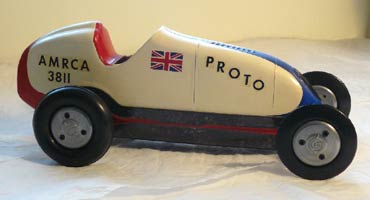 |
 |
|
Post-war American cars, Papina and Borden Teardrop |
|
It’s interesting to look at dates and timescales in relation to the beginnings, spread and decline of the hobby. There was obviously simultaneity of thought, possibly influenced by the already well established hobby of tethered hydroplane racing and the rapidly developing hobby of U–control or control line flying, invented by Jim Walker in 1942. This phenomenon of simultaneity has occurred in other activities, so it is not limited to model car racing.
Unbelievably, considering there was a war on, the first British tracks were built in the years 1942 and 1943 and apparently of only 13 to 14ft diameter. 1945 saw the first proper track of 42ft diameter built by Gerry Buck and colleagues in his parents’ garden in Stoke, and shortly after that, the famous Model Sportsdrome at Eaton Bray was opened.
|
|
Eaton Bray sported a 72ft diameter track, which became the standard imperial size, as it gave 6 laps to the ¼ mile. Both of these pioneering activities have been documented elsewhere, and the stories associated with each could form the content of a complete talk. Left: Eaton Bray Pathe video clip of Eaton Bray |
The hobby seems to have developed in Australia over a similar time–scale as here in the UK, with a 42ft diameter track being the original choice. This was followed by a 52ft diameter track constructed by filling in an existing annular or channel boat pond at the Sydney Society of Model Engineers’ facility at Ashfield. Later a full 72ft diameter track was built, which was to the usual 6 laps to the ¼ mile, the standard at the time. There were two main geographical centres of development in the early days, notably Sydney, New South Wales and Melbourne, Victoria. Later a club was formed in Brisbane, Queensland which is to this day one of the two remaining clubs in Australia. The other being the Sydney Society facility at Ludenham.
Australian class record holder Jim MacDonald
seen below in 1949 with a Meteor car (Dooling F copy), was from the Victoria
Miniature Race Car Club. One of a number of luminaries which included Charlie
Ballem of the Victoria Club, Harold King of the Sydney Society and Peter Larson
from Queensland.
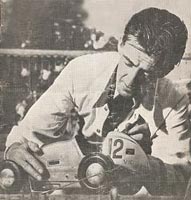 |
 |
|
| Jim MacDonald | Sydney members at Ashfield track | Harold King and Harry Ferguson |
It was extremely difficult for enthusiasts in Australia and New Zealand to obtain American or European commercial cars or engines resulting in large numbers of home built or small scale production items being raced in these countries. The best known being the Meteor cars and engines by Peter Larson and Charlie Ballem, later produced by Eric Price,and much copied since.
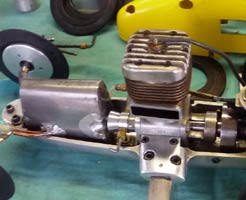 |
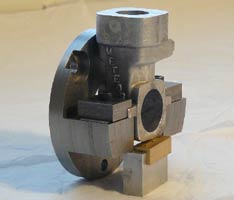 |
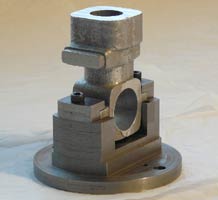 |
| Distinctive square barrel Meteor | Meteor crankcase casting and machining fixtures | |
Now we’ll move back to mainland Europe, which is now the focal point of the tether car community to see how the various countries became involved in tethered model car racing and when they developed their tracks and racing activities:
|
In Sweden, people were running cars as early as 1941, and certainly in 1946, as correspondence with the American magazine Rail and Cable News shows. Arne Zetterstrom reported in a letter that "a most successful race was held in a dance hall in Stockholm on October 7th". Right: The 'dance hall track' Lennard Forslof pushing off |
|
|
|
The first Swedish Championships were held in 1947. The Swedes are still very active participants to this day, although they are now a very small and ageing group, but amongst their number are names such as Arne Zetterstrom, Jan-Eric Falk, Nils Bjork and Mats Bohlin, all very influential innovators in the art of making cars go VERY FAST! Left: Orebro track (photo SMRU) |
|
The first international meeting was held on 1st October 1949 between the UK and Sweden. A team from Sweden, led by Erik Thorpman, was invited by the MCA (Model Car Association) to compete at the Surrey Club track at a place called Christmas Pie, now sadly covered by a cul-de-sac of rather nice bungalows. A reciprocal two venue race was held in Stockholm on 21st October and Orebro on 22nd October. Right: Swedish Team L-R Harry Fjellstrom, Erik Thorpman, Harry Blomquist, kneeling Ake Johannson Below: In front of John Oliver Snr is his famous 'Busy' with Gerry Buck's McCoy 'Curly' |
|
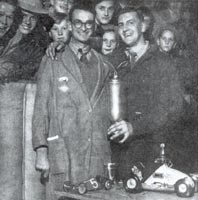 |
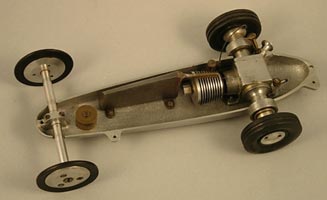 |
 |
| John Oliver Snr & Erik Thorpman | Tiger 25 proto with early Tiger twin-shaft | Bottoms-up with Mk 2 Tiger and curly carb |
|
The Olivers, father and son, were largely responsible for the development of the small diesel engine for competition purposes. Their twin-shaft units designed specifically for direct drive use in cars soon came to totally dominate the 2.5cc and 1.5cc classes, being used the world over. The cars they produced had an equally strong following, winning numerous competitions and regularly breaking records In more conventional form, the Oliver diesel in its various guises achieved the same level of success in model aircraft competition, creating a huge demand for the motors and setting a reputation for quality and performance that survives to the present day. Right: John Oliver preparing his cars at Orebro in 2007 |
|
France held its first National Championships in 1948, which was a combined meeting for control line aircraft and tether cars, the cars running on a track 15 metres in diameter using a line made of rayon. Quite surprising when one considers the devastation and upheaval of the occupation during the Second World War. There is only one track left in France, on the outskirts of Lyon and at the present time, (October 2011) its viability as a racing venue hangs in the balance as there are so few members available to maintain it. However, the French GP will be held as normal in 2012 and we wish them all the luck in the world in maintaining the track in first class order.
 |
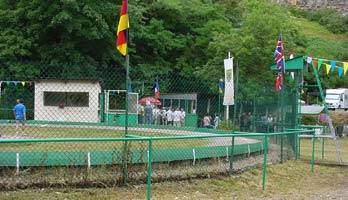 |
| Double circle at Dieppe for different classes | Lyon track at Couzon au Mont D'or |
|
Switzerland embraced tether car racing very early on, and became quite a focal point in the early post war years. Due to its unique situation after the Second World War, there were a lot of US personnel there, and as was the case in Australia and Great Britain, cars and motors found their way into the hands of Swiss enthusiasts. There were three tracks built, one in Geneva, one in Zurich and the third in Witterswil near Basel. The latter is still in use and within their site, which they own, is a very comprehensive outdoor gauge 1 railway layout. Right: Track at Witterswil near Basel |
|
Germany’s first meeting; or rather demonstration of tether cars, was at a gardening exhibition in Stuttgart in 1950, with its first dedicated track being built in Dortmund in 1957. Subsequent tracks being built in Hanover, Kapfenhardt and Hamelin in the years 1957, 1958 and 1959 respectively.
|
|
The tracks in Hanover and Kapfenhardt are active to this day. One further track was built at the instigation of Major Peter Rischer within the military base of Kerpen when he was based there as commander of a Starfighter wing. The track survives to this day within the barracks, but as Peter is now long–retired, nobody knows what it is, so it just gets swept and the surrounding hedges get trimmed on a regular basis. Left: Covered track in Kapfenhardt |
|
The first reference I have been able to find relating to the beginnings of the hobby in Italy is an article sent to Model Maker in 1950 describing a race meeting held in a hall within the Alfa Romeo site in Milan. The first track was built within Monza Great Park in 1951; it is still in use and is situated just behind the main pits area. It can sometimes be seen during overhead panning shots from the Grand Prix. It was originally set out with three concentric circles, as the Italians used different line lengths for the different engine sizes in the early days. Right: Monza track in 1951. Circles of 15.94, 23.84, 31.84metres diameter |
|
1952 is an important reference point (remember the dates, timescales and coincidences?) as it was the year in which FEMA (Federation Europeene du Modelisme Automobile) the European governing body was founded and also the year in which the first European Championships were held, at the now long–defunct track in Geneva. This really marks the beginning of the ‘modern era’ of tether car racing.
At this point we must make a diversion which is very important to the later development of tether car racing, indeed to the whole world of racing two-stroke engines:
Around the same time as tether car racing was becoming established and the first European Championships were being planned in Switzerland, a young motor racing enthusiast called Daniel Zimmermann living in the region of Lower Saxony in East Germany was developing a ‘membrane rotary valve’ induction system. This was to improve the performance of a 125cc two-stroke racing motorcycle called the ZPH, from the initials of the partners involved in the project (Zimmermann, Petruschke & Henkel). He also designed and built a double split single 500cc two–stroke engined formula 3 racing car, for which he designed a similar induction system. The advantage of the rotary inlet valve is that it can be set up to give a much longer induction period than a conventional piston ported engine, very important for gaining more power from the humble two–stroke engine.
 |
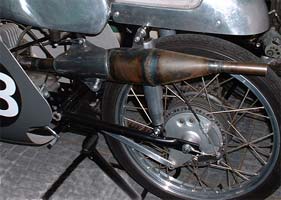 |
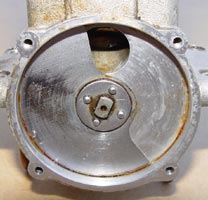 |
|
The
IFA of 1953 shows that Kaaden was using the Zimmermann rotary valve
(note the position of the carburettor) but still with megaphone exhaust. |
The MZ 125 RE of 1963 with Zimmermann rotary valve and full resonant exhaust system | Zimmermann disc valve |
At around the same time, in the town of Zschopau in Lower Saxony, a very talented development engineer by the name of Walter Kaaden was appointed chief of the racing department of the company IFA DKW, later to become MZ. He is usually referred to as the father of the modern racing two–stroke, and the reason for this title is that he almost single handedly, but obviously with the help of his small team of mechanics, designed and developed the tuned length exhaust system. This harnessed the energy of the exhaust gases to produce spectacular increases in the power of the two–stroke engine. He also reasoned that his tuned length exhaust combined with the Zimmermann rotary valve would further enhance the performance of his racing motorcycles. Of course, he was absolutely correct. Over time, it enabled the two–stroke racing engine to increase its specific output from some 60 bhp/litre to the figure 0f 500 bhp/litre common today.
The photos of the MZs were taken by me when I visited the Museum at Schloss Augustusburg in the former East Germany. (In his final years, Walter Kaaden was curator of this museum until shortly before his death.)
©copyrightDavidGiles2012